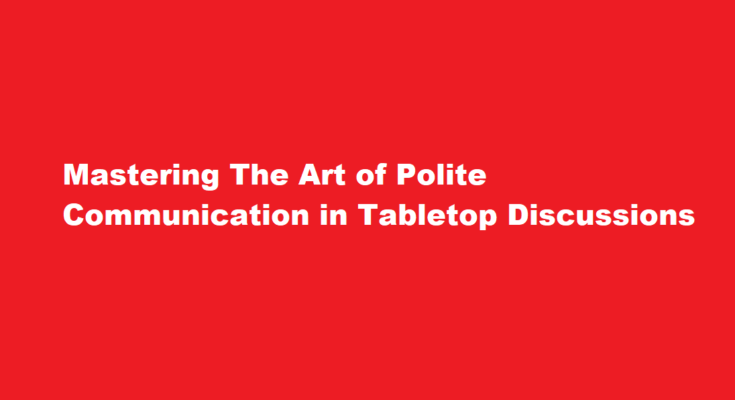In the realm of communication, politeness serves as a cornerstone for fostering meaningful interactions and maintaining harmonious relationships. This principle is particularly pertinent when engaging in tabletop discussions (TT), where diverse viewpoints converge. The ability to communicate politely during these discussions not only promotes constructive dialogue but also cultivates an atmosphere of respect and collaboration. In this article, we delve into the nuances of polite communication in tabletop discussions and provide practical tips to navigate these conversations effectively.
Understanding the Importance of Politeness in TT
Tabletop discussions encompass a wide array of scenarios, ranging from professional meetings and academic debates to informal group conversations. Irrespective of the setting, the essence of politeness remains constant. Polite communication demonstrates an acknowledgment of others’ perspectives, and it encourages a free exchange of ideas without devolving into conflict. By prioritizing politeness, participants create an environment where everyone feels valued and heard.
Active Listening as a Foundation
Effective communication begins with active listening. When engaged in a tabletop discussion, make a conscious effort to truly understand the speaker’s point of view before formulating your response. Maintain eye contact, nod to show your attentiveness, and refrain from interrupting. This not only shows respect for the speaker but also ensures that your own contribution is relevant and considerate.
Choose Your Words Wisely
The words we use can either bridge gaps or create barriers in communication. Polite language entails using words that are neutral and considerate. Avoid confrontational phrases or tone, and instead, opt for inclusive language. For instance, replacing “You’re wrong” with “I see what you mean, but I have a different perspective” can significantly alter the course of the conversation.
Be Mindful of Non-Verbal Cues
Communication isn’t just about the words we speak; non-verbal cues play an equally crucial role. Maintain an open posture, avoid crossing your arms, and refrain from displaying signs of impatience. Smiling, nodding, and maintaining appropriate eye contact convey your engagement and encourage a positive atmosphere.
Embrace Empathy
Empathy is the cornerstone of polite communication. Endeavor to understand the emotions underlying others’ viewpoints. Acknowledge their feelings, even if you disagree with their stance. Expressing empathy doesn’t imply agreement; rather, it shows that you value their emotions and opinions.
Constructive Criticism with Care
In tabletop discussions, differences of opinion are inevitable. When offering criticism, frame it in a constructive manner. Start by acknowledging the strengths of the opposing viewpoint before respectfully presenting your own counterarguments. Avoid personal attacks or dismissive language, as they hinder productive discourse.
Utilize “I” Statements
When expressing your thoughts, use “I” statements to convey your perspective without imposing it on others. For instance, saying “I believe” or “In my opinion” communicates that you are sharing your viewpoint rather than asserting an absolute truth. This approach encourages an open exchange of ideas without belittling anyone else’s thoughts.
Mindful of Cultural Sensitivities
Tabletop discussions often involve participants from diverse backgrounds, each with their own cultural norms and communication styles. Being mindful of these differences is essential to ensure that your words and actions don’t inadvertently cause offense. Educate yourself about cultural sensitivities and adapt your communication approach accordingly.
Dealing with Disagreements
Disagreements are natural, but they need not devolve into conflicts. Polite communication involves staying focused on the issue at hand rather than attacking the person presenting it. Use phrases like “I respectfully disagree” or “I can see where you’re coming from, but I have a different perspective” to navigate differences without escalating tensions
Graciously Concluding the Discussion
As the tabletop discussion reaches its conclusion, take a moment to summarize the key points and express gratitude for everyone’s contributions. Even if the discussion hasn’t led to a unanimous agreement, the tone and attitude you exhibit during the conclusion can leave a lasting impression of your polite and respectful communication.
FREQUENTLY ASKED QUESTIONS
How do you talk to someone in a formal way?
In a more formal greeting it is appropriate for you to say, “How do you do?” and “Nice to meet you” and to address the people you are meeting with the correct title of Mr./Mrs./Ms., Dr., Rev., etc. With those you know well, you probably say “Hi”, “Hey, What’s up?” or “How’s it going?”
What is a polite language?
showing good manners toward others, as in behavior, speech, etc.; courteous; civil. a polite reply. 2. refined or cultured.
In conclusion, the art of talking politely in tabletop discussions is a skill that fosters collaboration, understanding, and productive dialogue. By actively listening, choosing words carefully, embracing empathy, and respecting cultural differences, participants can navigate even the most contentious discussions with grace. The power of polite communication lies not only in the ideas shared but also in the relationships built through respectful engagement.
Read Also : Streamlining Your Experience A Guide to Efficiently Checking Tickets Online



